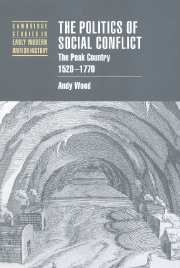Book contents
- Frontmatter
- Contents
- List of figures
- List of tables
- List of maps
- Preface
- List of abbreviations
- Introduction ‘Terms we did not understand’: landscape, place and perceptions
- 1 Social relations and popular culture in early modern England
- Part I The structures of inequality
- 2 Economy and society in the Peak Country, c. 1520–1570
- 3 Industrialization and social change, c. 1570–1660
- 4 The Peak Country as an industrial region, c. 1660–1770
- 5 Social conflict and early capitalism
- Part II The conditions of community
- Part III The politics of social conflict
- Bibliography
- Index
- Cambridge Studies in Early Modern British History
4 - The Peak Country as an industrial region, c. 1660–1770
Published online by Cambridge University Press: 27 July 2009
- Frontmatter
- Contents
- List of figures
- List of tables
- List of maps
- Preface
- List of abbreviations
- Introduction ‘Terms we did not understand’: landscape, place and perceptions
- 1 Social relations and popular culture in early modern England
- Part I The structures of inequality
- 2 Economy and society in the Peak Country, c. 1520–1570
- 3 Industrialization and social change, c. 1570–1660
- 4 The Peak Country as an industrial region, c. 1660–1770
- 5 Social conflict and early capitalism
- Part II The conditions of community
- Part III The politics of social conflict
- Bibliography
- Index
- Cambridge Studies in Early Modern British History
Summary
THE ECONOMICS OF REGIONAL IDENTITY
In the year of the restoration of the Stuart monarchy, the Derbyshire lead mining industry stood upon the turning crest of rapid change. The deep mines near Wirksworth whose production had faded out in 1658 presaged the growing domination of large-scale capitalism within the industry. Coincidences of source material between 1639 and 1664 have allowed us to map long-term changes in population, together with the distribution of mining households and the significance of industrial activity within the Peak in the early 1640s. The Hearth Tax records of 1664 have already been deployed as a source of information about the distribution of population. The full survival of the Hearth Tax returns also sheds light on the forms assumed by the social structures of the mining area at the point at which long-emergent capitalist relations of production began to acquire local domination within the mining industry.
Economic and social historians have used Hearth Tax returns as a rough indicator of local patterns of wealth and poverty in mid-seventeenth-century England. The Hearth Tax assessed named heads of households upon the number of hearths within their dwelling. A general and consistent correspondence has been observed between the number of hearths on which a householder was assessed, and their discernible wealth as drawn from other sources. Importantly, those regarded as unable to pay on the grounds of ‘poverty or smallness of estate’ were exempted from payment. On some assessments, such as those for Derbyshire for 1664, these exempted householders are also named.
- Type
- Chapter
- Information
- The Politics of Social ConflictThe Peak Country, 1520–1770, pp. 89 - 112Publisher: Cambridge University PressPrint publication year: 1999



